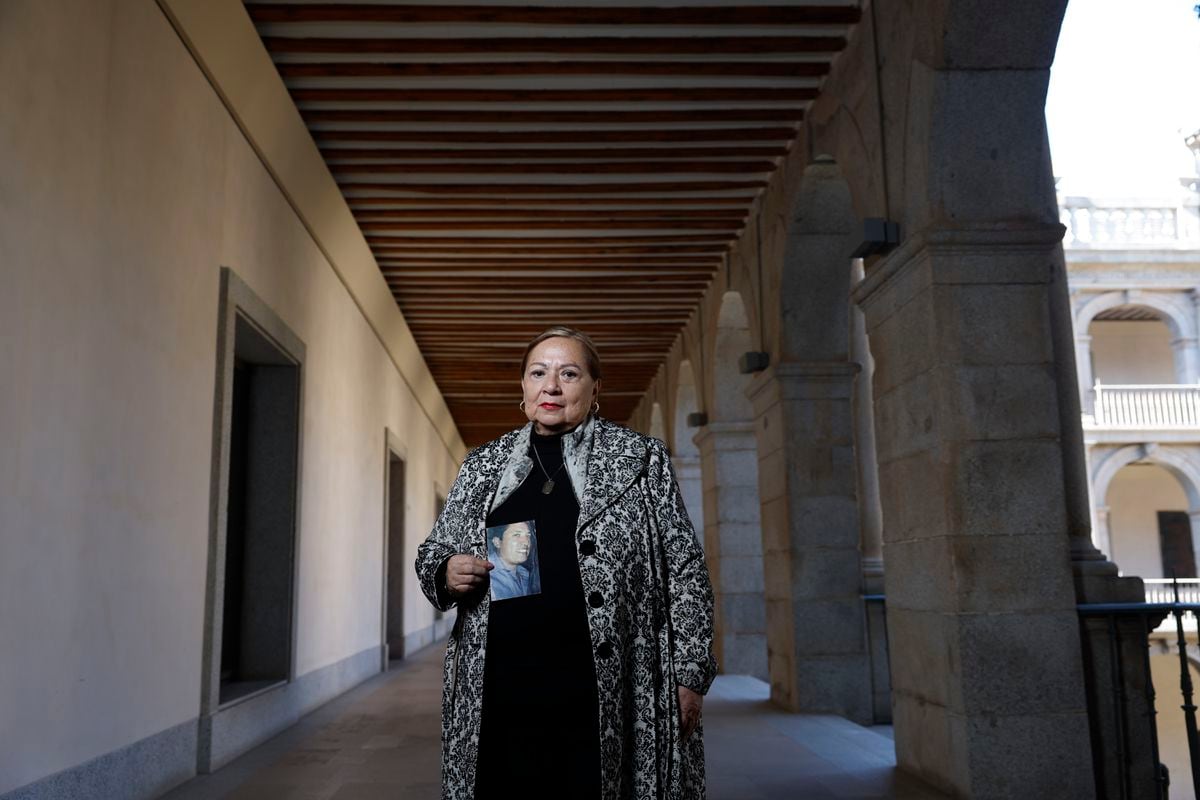It was one of the most important news stories of the 20th century, but no newspaper, radio or television covered the discovery of the structure of DNA when it occurred, 70 years ago today.
And that the protagonists of the story knew how to sell their achievement very well: "We have discovered the secret of life", declared the English Francis Crick when breaking into a cocktail bar in Cambridge (United Kingdom) hugging his scientific partner, the American James Watson.
Two months after this unconventional scoop, Watson and Crick made the formal announcement in
Nature
.
The prestigious scientific journal casually published its solution to the puzzle that had baffled biologists for decades: How are genes passed from parent to child?
Although deoxyribonucleic acid (DNA) was not unknown to science in 1953, it still had a bad name.
Despite the fact that several experiments with bacteria in the 1940s had shown that genes are made of DNA, even the authors of those discoveries did not quite believe that this was the molecule of life.
It seemed too simple and monotonous.
Even some of its scholars referred to it as the stupid molecule, when DNA was thought to be just a long chain in which four basic units (A, C, G and T) were repeated over and over again.
Most expected it to be discovered that genes were also made of proteins, much more varied molecules.
But a few researchers thought that the secret of DNA might lie in the structures it could form.
The idea of strands of DNA coiled in the form of helices began to float in scientific circles.
Only Watson and Crick managed to land it correctly.
Watson and Crick's little paper in
Nature
in April 1953, in which they presented the double helix, completely changed the view of DNA.
It was no longer a monotonous molecule, because that structure allowed infinite variety in the sequence of A, C, G, and T units within a very long chain.
In fact, it was no longer one but two chains, and also complementary to each other, as if one were the photographic negative of the other.
That double helix was not only astonishing because of its beauty and simplicity, but also because that DNA structure said a lot about its function: it could contain very long messages inside it, well protected, and it also included a system for photocopying.
The formerly known as stupid molecule was the perfect candidate to carry genetic information.
This is how Francis Crick had anticipated it to his 12-year-old son in a tender and emotional letter written on March 19 of that year: “We believe that DNA is a code.
That is, the order of the bases (the letters) makes one gene different from another (just like one page in a book is different from another).
And you can also see how nature makes copies of genes.
If the two strands unravel and separate, and a complementary one is built on top of each strand (because A always goes with T and C always goes with G), we will have two copies [of the double helix] where we had one before,” Crick wrote.
Neither he nor his research partner dared to say it with that forcefulness, only to hint at it at the end, in their first article on the double helix.
Genetic information, a visionary idea
The scientific bombshell was dropped in a second, broader study, also published six weeks later in
Nature
: "The precise sequence of the bases is the code that stores the genetic information," Watson and Crick affirmed.
That phrase sums up the genius and visionary character of this scientific couple, as explained by Matthew Cobb in his book
Life's Greatest Secret
: “No one had referred to
genetic information
before .
It was a concept that Watson and Crick had just invented.
It sounded very strange, but also familiar, because it fit very well with the ideas that were in the air [in the scientific community] at the time.
It was immediately accepted by scientists around the world.”
Instead, the answer to the big question in biology went completely unnoticed at first by the general public.
England celebrated events that seemed much bigger that year, such as the coronation of Queen Elizabeth II or the first climb to the top of Everest.
The only British newspaper that covered the issue in 1953 was the
News Chronicle
, which published a note on May 15 (
Closer to the secret of life
) in which the head of Watson and Crick at Cambridge University, Sir Lawrence Bragg, spoke of an exciting discovery “about the substance that transmits hereditary traits such as eye color or nose shape.
The way in which these characteristics are passed from generation to generation depends on the sequence of four chemical groups.
Figuring out how those cards are shuffled and dealt will keep scientists busy for the next 50 years."
And so it was, exactly: the double helix started a scientific revolution that culminated in 2003 with the complete sequencing of the human genome.
Today both milestones are commemorated in scientific and educational centers around the world (in their 70th and 20th anniversary, respectively) and in the US National DNA Day is celebrated every April 25.
But then little else was known about that story.
How to see invisible molecules
Partly due to ego struggles and the controversial way in which they completed their model, Watson, Crick and the double helix remained unknown for years.
That first news did not mention them.
He talked about how the discovery had been made by two teams of young scientists using X-rays, one in Cambridge and one in London.
The others, from London, were Maurice Wilkins and Rosalind Franklin, who did all the experimental work.
The DNA strands are so extremely fine that they were impossible to see under a microscope back then (even now they cannot be seen in detail with today's most powerful electron microscopes), so to know their structure it was necessary to resort to a kind of X-rays. , X-ray diffraction patterns, which give clues to the shape of molecules.
Wilkins and Franklin were two leading experts in X-ray diffraction, and their laboratory at King's College London obtained images and data that were crucial to Watson and Crick's ability to deduce the DNA double helix and pin down the details of its structure.
For almost two years, both teams shared their progress, and it was Rosalind Franklin who in 1951 demolished the first attempt by Watson and Crick to create a model of DNA: it was a triple helix, which she made them see was chemically impossible and that he had the chains backwards than his experiments showed.
Following that failure, Sir Lawrence Bragg forbade Watson and Crick from further work on DNA.
But he changed his mind a year later.
When he learned that his archrival, the American Linus Pauling, was about to announce his solution to the problem, he encouraged them to resume their daring investigations and win that scientific career for Cambridge's Cavendish Laboratory.
Meanwhile, in the London team the atmosphere had become unbreathable, as Maurice Wilkins and Rosalind Franklin couldn't stand each other anymore and she had asked to be transferred to another center.
Watson and Crick went to work frantically, making multiple combinations with mockups of the parts of DNA made from pieces of cardboard and metal.
When the pieces fit, they checked with their mathematical calculations that the positions were viable.
Replica of the original model used by Francis Crick and James Watson to deduce the double helix structure of DNA.SSPL via Getty Images
Foul play in the final 'sprint'
The controversy arose because Watson and Crick did not ask their colleagues for this data directly or advise them that they were using it or their latest progress towards the double helix until they had completed it.
They got their hands on this preliminary (as yet unpublished) data informally from their bosses and wrote down the scoop for themselves, mentioning Wilkins and Franklin only lightly at the end of their article.
What they did was not illegal but they did it secretly from their colleagues, without playing fair.
James Watson declined to give interviews in 1953 because he believed more research was needed to confirm the double helix and because he feared being publicly accused of stealing data, as revealed by his biographer Victor K. McElheny in the book Watson and
DNA
.
The truth is that neither Maurice Wilkins nor Rosalind Franklin accused them of that.
Watson and Crick continued to expand on their theory and in a new article, written that summer and published in 1954, were much more fair to the other two fathers of the double helix: “We are tremendously grateful to the King's College group and want to stress that, without their data, the formulation of our structure would have been most unlikely, if not impossible," they wrote in the Proceedings
of the Royal Society of London.
.
In that review of their work, they made multiple mentions of Franklin and Wilkins from the very first paragraphs, acknowledging that they had only tested structures compatible with their data when they created the model.
The double helix of Watson, Wilkins, Crick and Franklin is today an icon of science, something like the
Mona Lisa
of biology.
His discovery culminated in 1953 the scientific race to understand genetic inheritance, which began in 1869 when DNA was discovered.
After seven decades of research, many scientists had made important discoveries, but an important piece of the puzzle was missing.
They found it in less than two years and changed the history of science, despite fights, interruptions and disloyalty in collaboration.
And they did it thanks to the precise experiments of Wilkins and Franklin, in combination with the theoretical skill of Watson and Crick, whose intuition and ability to speculate without prejudice helped them to understand and fit the pieces previously contributed by other researchers.
1869
Discovery of nuclein (DNA).
Friedrich Miescher finds, in the nucleus of cells, a substance rich in phosphorus and nitrogen.
Its function is unknown and he calls it "nuclein".
1876
Sexual reproduction under the microscope.
Oscar Hertwig sees how the sperm penetrates the egg and their nuclei fuse.
He later suggested that nuclein is the substance responsible for the inheritance of biological traits.
1880s
Chromosomes and cell division.
Wilhelm von Waldeyer-Hartz calls the colored bodies that appear in the nucleus during cell division "chromosomes", which Walther Flemming had described shortly before.
1902
Chromosomal theory of heredity.
Theodor Boveri and Walter Sutton explain the mechanisms of the laws of genetics, which had been discovered in 1865 by the Austrian monk Gregor Mendel, experimenting with peas.
1909-1929
The chemical composition of DNA.
Phoebus Levene studies the composition of the nuclein discovered by Miescher and gives it its current name: deoxyribonucleic acid (DNA).
1915
Genes are on chromosomes.
Thomas Hunt Morgan demonstrates, through experiments with the fruit fly, that genes are located in specific places on the chromosomes, confirming the Boveri-Sutton theory.
1944
DNA is the carrier of genes.
The Avery, MacLeod and McCarty experiment confirms that DNA is the substance that causes genetic alteration in bacteria.
1950
The bases are paired.
Erwin Chargaff discovers that in DNA there is always the same proportion of adenine (A) and thymine (T) on the one hand, and cytosine (C) and guanine (G) on the other.
In addition, its composition varies from one species to another.
1952
Photo 51: the best X-ray of DNA.
Raymond Gosling and Rosalind Franklin obtain a very sharp X-ray diffraction image of DNA.
It undoubtedly confirms the suspicions that there are helices in the molecule.
1953
The double helix.
James Watson and Francis Crick elaborate their model of the structure of DNA.
X-ray data from Rosalind Franklin and Maurice Wilkins confirm that it is correct.
1957
The dogma of molecular biology.
Francis Crick continues to expand the theory of genetic information and enunciates his central dogma: information is transmitted from DNA to RNA, and from RNA to protein.
1960s
The genetic code.
Marshall Nirenberg and Severo Ochoa, among others, decipher the mechanisms by which the DNA code is transcribed to make proteins.
The double helix theory is definitely accepted.
You can follow
MATERIA
on
,
and
, or sign up here to receive
our weekly newsletter
.
Subscribe to continue reading
Read without limits
Keep reading
I'm already a subscriber









